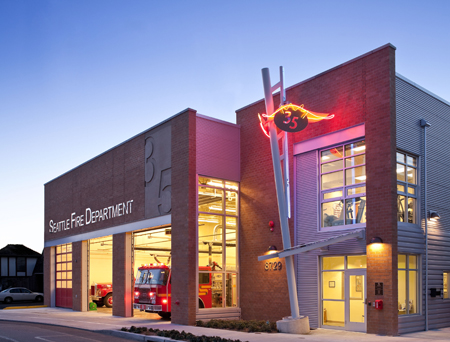
Seattle Fire Station No. 35
Architect: Rice Fergus Miller
Civil engineer: Warner Engineering
Owner: City of Seattle
ABC members: Kibble & Prentice (a USI Co.), Propel Insurance
The original Fire Station No. 35 in Seattle was built in phases starting in 1920 when horses pulled fire-fighting equipment.
The replacement station consists of a two-story, 11,500-square-foot building constructed on a zero-setback lot. This created many challenges for the construction team, as there was no room for storage, lay down, equipment or even a job trailer.
Rice Fergus Miller began design of the project following its selection in December 2006.
Although the city only required the project to be built to LEED silver standards, general contractor Kirtley-Cole Associates was able to achieve gold certification through design, quality control during construction, and collaboration with subcontractors and other team members.
Some of the sustainable characteristics include 100 percent covered parking to reduce the heat-island effect, brownfield development, a 30 percent increase in air ventilation and low-VOC materials.
The station operates with impressive energy efficiency because of the HVAC system, which uses individual controls in the sleep rooms and living areas, as well as a design that cost-effectively heats the apparatus bay and working spaces. The design and construction of the building uses as much natural lighting as possible to achieve a balance between low lighting costs and maintaining energy efficiency.
To conserve space, Kirtley-Cole constructed the apparatus bay with finishes to allow for indoor truck washing. The building also has a fully contained indoor decontamination center and several multiuse centers for storage of fire-fighting equipment.
The urban lot proved challenging for demolition of the old structure, which stood 20 feet taller than the adjacent building. Crews systematically demolished the old building, pulling the walls in as the process evolved.
On-site soil was found to be unacceptable for reuse as structural subgrade, so a concrete treatment was used to reinforced it. This not only saved the expense of exporting the material and then importing new, but also time in the construction schedule. The solution was also more environmentally friendly.